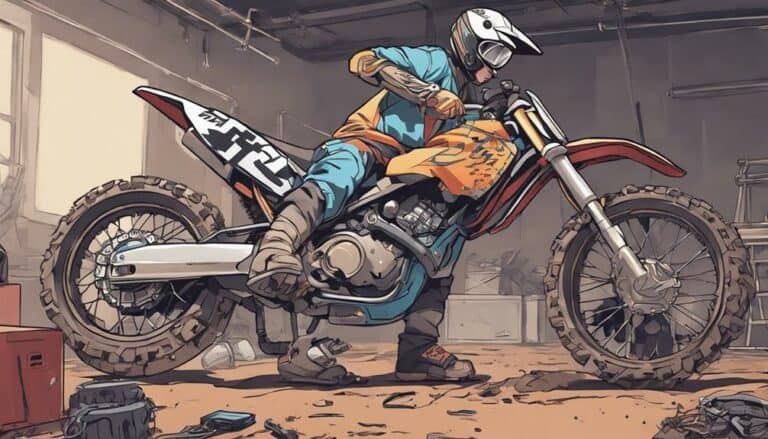To upgrade the stator on a dirt bike, start by selecting a superior stator that suits your bike's specifications.
However, the process doesn't end there; you need to meticulously handle the installation to guarantee seamless integration.
Upgrading your stator can greatly boost your bike's electrical capabilities, enhancing its overall performance.
Key Takeaways
- Choose a higher-wattage stator for increased power output and better lighting performance.
- Ensure compatibility and easy installation with pre-wired components.
- Use the right tools like a multimeter for testing and successful upgrade.
- Monitor performance, voltage output, and temperature to prevent issues and ensure optimal operation.
Benefits of Upgrading the Stator
Upgrading the stator on your dirt bike offers a range of advantages that greatly enhance its electrical performance and customization potential. By opting for a higher-wattage stator, you can considerably increase the power output available for additional accessories such as lights, fans, or audio systems.
This upgrade not only allows for improved lighting performance, enhancing visibility during night rides or in low-light conditions, but also safeguards a stable electrical system. Preventing overloading of existing components like the regulator or battery, upgrading the stator is a vital solution for dirt bike enthusiasts seeking to customize their bike's electrical capabilities without compromising reliability.
Moreover, the benefits extend to easier installation, better heat dissipation, and long-term maintenance advantages, resulting in a more robust electrical system overall. Upgrading the stator is a vital step towards enhancing both the performance and versatility of your dirt bike, providing you with the freedom to tailor its electrical setup to your specific needs and preferences.
Choosing the Right Upgraded Stator
When selecting an upgraded stator for your dirt bike, make sure to carefully assess the power requirements of additional accessories like lighting, cooling fans, or audio systems. It's important to look for a stator with a higher wattage output to support increased electrical demands without compromising the bike's performance. Compatibility with the existing electrical system is key, making sure that the upgraded stator can be easily installed without major modifications.
One essential feature to think about is whether the upgraded stator comes with a pre-wired voltage regulator. This component simplifies the installation process and guarantees proper power management. Verifying that the upgraded stator is designed to improve overall electrical output and provide stable power for various components on the dirt bike is also important. By choosing the right upgraded stator with these considerations in mind, you can enhance your bike's electrical capabilities and performance while enjoying the freedom to customize it to your liking.
Tools Needed for Stator Upgrade
To prepare for upgrading the stator on your dirt bike, gather the necessary tools such as a socket set, wrenches, screwdrivers, and a multimeter for testing. These tools are essential for a successful stator upgrade:
- Socket Set: A complete socket set with various sizes will help you remove different bolts and nuts on the bike efficiently.
- Wrenches: Having a set of wrenches, including both open-end and box-end types, guarantees you can access and tighten bolts in confined spaces.
- Screwdrivers: Phillips and flathead screwdrivers are crucial for removing screws holding the stator cover in place.
- Multimeter: This tool is crucial for testing the electrical output of the stator before and after the upgrade to guarantee proper functioning.
Step-by-Step Guide to Upgrading
Considering the intricacies of enhancing your dirt bike's performance through a stator upgrade, your initial step involves carefully evaluating the compatibility of the selected high-wattage stator with your specific bike model.
Look for a plug-and-play stator that fits seamlessly into your bike's electrical system, ensuring it aligns with the power requirements and mounting points of your model. Opt for a stator that comes with a pre-wired regulator rectifier, simplifying the installation process. Remember to upgrade the voltage regulator to manage the increased wattage efficiently.
Following a detailed wiring diagram is important to correctly connect the stator, regulator rectifier, and battery. This step-by-step approach will guarantee a smooth and successful upgrade, allowing you to enjoy the benefits of enhanced power output without complications.
Testing the New Stator's Performance
Testing the performance of the new stator involves measuring the voltage output across the stator leads while the engine is running. To guarantee an accurate assessment, follow these steps:
- Use a Multimeter: Set the multimeter to AC voltage mode and connect it to the stator leads to check for consistent voltage output at various RPMs.
- Check Manufacturer's Specifications: Verify that the stator is generating voltage within the expected range as specified by the manufacturer.
- Test Under Load: Connect additional electrical accessories to the system to observe how the stator responds to increased power demands.
- Conduct a Heat Test: Monitor the stator's temperature during operation to identify any overheating issues that may indicate problems with heat dissipation or regulator capacity.
Conclusion
Optimizing the stator on your dirt bike can significantly improve performance and prevent overheating issues. By selecting the right stator and voltage regulator, carefully wiring new components, and conducting thorough testing, you can enhance the electrical system efficiently.
Guarantee proper heat dissipation and regulator capacity to maximize the benefits of the upgrade. Upgrade with precision and attention to detail for best results.

